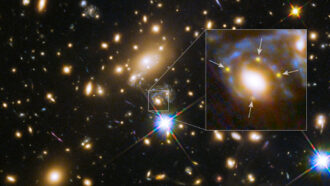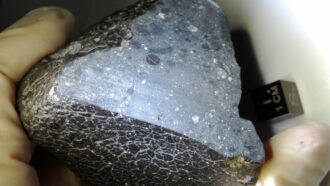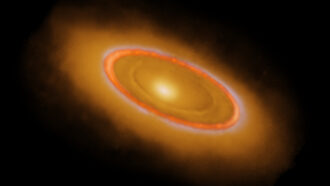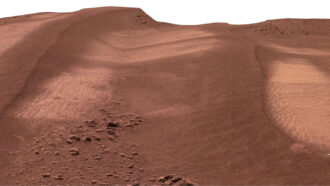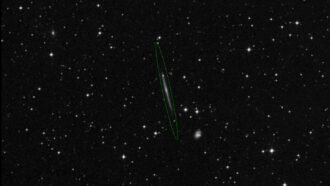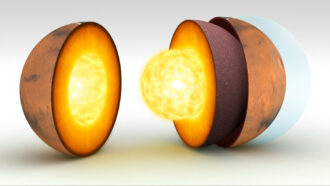By Nadia Drake
Two small planets might be sculpting an enormous dust ring around the star Fomalhaut, a mere 25 light-years away from Earth.
But it’s not too likely that either planet is the notorious Fomalhaut b, which once held the title of the first directly imaged exo-world (SN: 12/6/08, p. 5).
New observations have revealed that the ring is thin, with sharp inner and outer edges — an unlikely shape, unless something is keeping the ring particles neatly in line.
“The best explanation so far is that there are two planets out there,” says astrophysicist Aaron Boley of the University of Florida, coauthor of a study to appear in Astrophysical Journal Letters.
Boley and his colleagues looked at the Fomalhaut system because they wanted to know how planets that are very, very far from their star might differ from planets that are snuggled closer in. Fomalhaut’s ring is more than 100 times farther afield from its star than Earth is from the sun, and any potential ringscaping planets would be similarly far-flung.
The team used the Atacama Large Millimeter/submillimeter Array, a collection of radio telescopes in the Chilean high desert that can detect dust particles up to a millimeter across, about the size of small sand grains. ALMA can map the location of particles that are tugged around only by the gravity of planets and not by the radiation from a star. “We want to look at material that’s only affected by the planet,” Boley says.
The new observations paint a picture of a ring with unexpectedly well-defined edges — the trademark handiwork of what are called shepherding bodies. “We do see a similar scenario in our solar system, with the Epsilon ring of Uranus being herded by two small moons,” says astrophysicist Ray Jayawardhana of the University of Toronto.
Instead of moons, though, shepherd planets might be responsible for the Fomalhaut ringscaping — one brushing up the inner edge, and the other tidying the outer edge. The orbs are each probably between the size of Mars and a super-Earth, too small to be seen or directly detected with available technologies.
“These sharp edges of the disk do indicate that there should be some planet in there that hasn’t necessarily been seen yet,” says astronomer Markus Janson of Princeton University. But both he and Jayawardhana advise caution until more observations are made.
The Fomalhaut system has long puzzled astronomers. Early images from the Hubble Space Telescope revealed what some thought was light coming from a giant, Jupiter-sized planet called Fomalhaut b, which was clearing the ring’s inner edge. But later work revealed that the candidate planet was behaving strangely — its brightness varied, and its orbit was wrong. Now, astronomers on the team that published the discovery have revised their estimates of the planet’s size. “Our favored explanation for Fomalhaut b is that it represents a relatively low mass planet surrounded by a dusty ring or cloud which reflects starlight,” says astronomer Paul Kalas of the University of California, Berkeley.
But others aren’t sure the candidate planet is there. Janson and his colleagues, who studied the Fomalhaut system in infrared light, concluded that the original image might have just captured light reflecting off a dust cloud. It’s possible that the dusty cloud could be surrounding a much smaller planet, but Janson says it’s too soon to tell.
It’s possible that the inner shepherd planet could be a shrunken Fomalhaut b, says Boley, but he says he would have to twiddle with estimates of the planet’s distance from the star. He notes that although the details might vary, the overall tale of Fomalhaut is still fundamentally the same. “The best explanation for the ring is that it’s being shaped by planets. And that’s not changing,” Boley says. “What’s changing is the mass and orbits of potential planets.”

